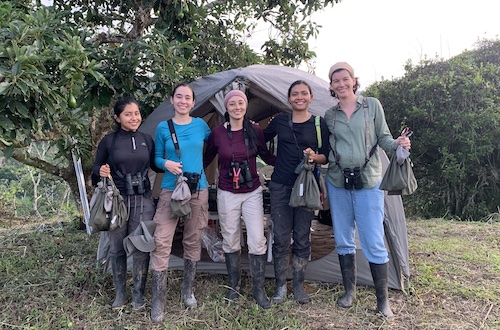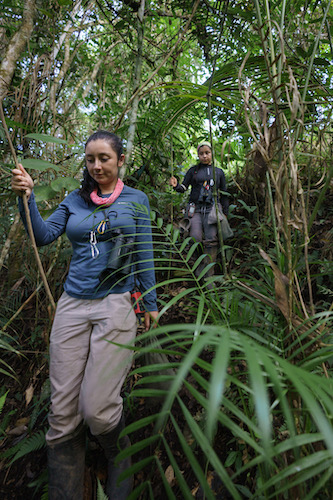Many fields of study have long been dominated by men but a team of eight female Colombian researchers are committed to uncovering the story of naturalist pioneer Elizabeth Kerr, whose legacy had remained invisible despite her vast contributions to ornithology.
Natalia Ocampo-Peñuela, assistant professor of Environmental Studies at UC Santa Cruz, is the senior scientist on the team that was led by ornithologist and University of Illinois, Urbana-Champaign PhD student Juliana Soto-Patiño. The other team members are: Estefanía Guzmán, Daniela Garzón, Katherine Certuche (all local ornithologists of Tolima), Nelsy Niño the community-engagement leader of the BIO expedition project, and Jessica Niño and Natalia Pérez, both young ornithologists of the BIO expeditions.
Since first finding her contributions in September 2020, the group has written about Kerr’s work and history, in the context of underrepresentation of women in the science prevalent in historical understandings of naturalism, and published by Ornithological Applications later this spring.
Ocampo-Peñuela and Soto-Patiño began their work with this team while working full-time at the Alexander von Humboldt Biological Resources Research Institute (IAHV) in Bogota, leading a project called the BIO Expeditions. It was during those expeditions that their team examined locations across the country that had been surveyed by the American Museum of Natural History between 1911 and 1915, and led to their collective discovery of Kerr’s work.
In the 1900s, Ocampo-Peñuela said, ornithologist Frank Chapman — one of the most renowned American ornithologists — led a team of white, all-male naturalists throughout Colombia, visiting 74 sites throughout the country and collecting approximately 16,000 bird specimens. The group then took that work back to New York, to study the distribution of birds across South America.
“What we were doing was to examine how the bird communities had changed over the last 100 years,” Ocampo-Peñuela explained. “We wanted to revisit some of these places, and do the contemporary bird collections ourselves.”
In preparing for those initial expeditions to the Tolima localities, in September 2020 the team read through historical texts, mostly from the 1917 book “The Distribution of Birds in Colombia,” by Frank Chapman. It was during that research where the team stumbled upon the “Mrs. Kerr Collection,” ultimately leading to their discovery of the forgotten female collector and naturalist.
“We had all trained as ornithologists, and never in the early history of Colombian ornithology had we seen a female name,” shared Soto-Patiño.
The team directed their efforts to learn more about Kerr, and immediately contacted the Ornithology collection at the American Museum of Natural History to see if they had more information on Kerr’s work. The Museum was “incredibly helpful,” said Ocampo-Peñuela, providing the team with specimen lists and pictures that Kerr had collected in the early 1900s. Ultimately, the connection that led to a great deal of intrigue and excitement for the group was the discovery of letters between Kerr and Frank Chapman, housed in the Ornithology collection archive at the AMNH which were shared with the team.
Through those letters, the team was able to find that Kerr was not an official employee, but would sell bird specimens to the museum.
The research and expeditions during this time — while COVID-19 was still highly prevalent around the world — were difficult to manage and plan for. Soto-Patiño, expedition leader and lead author on the paper, said the teams would follow strict protocols as PCR before quarantining prior to each expedition, and everyone wore masks while hiking throughout the areas.
Finding Kerr was “surprising,” to say the least.
“For any research area in science, many times we know a little bit about the early history and the people who have developed the main research in the field,” Soto-Patiño said. “For Colombian ornithology, in the 1970s or 1980s, you start to see women in this history — but prior to that, you never had.”
The team, as both Ocampo-Peñuela and Soto-Patiño explained, are incredibly excited for their findings to be published in Ornithological Applications, one of the two largest ornithology journals in the United States. The piece will be published in both English and Spanish, to ensure accessibility for Latin American people.
That’s made all the more impressive when considering that their findings were the result of a side project, not their initial expedition goals.
“We were very dedicated because, as women, Kerr was a role model that we had been longing for but never had,” Ocampo-Peñuela said. “Elizabeth is still someone foreign to Colombia, but we shared part of her identity…we had this one connection with her.”
Said Soto-Patiño, “it’s important for the next generations to have these references in history…Elizabeth was a great finding for ornithology as a whole, but also for women and science in general.”
Together with the Kerr findings, the authors include in the paper the description of an all-female expedition they carried out in one of the localities where Kerr collected birds, to honor her legacy and exalt the roles and contributions of women in science.
The team of researchers has spread out since their original expedition — Ocampo-Peñuela in Santa Cruz, Soto-Patiño in Urbana-Champaign, and the rest of the team in different regions in Colombia — but the experience has kept them together.
“This is a chance for us to understand more about the history we have lost, and examine how we can right these wrongs when addressing women’s findings into the future,” Ocampo-Peñuela said. “Women are capable of doing expeditions, and we want to show girls that are watching they can do this work too.”




